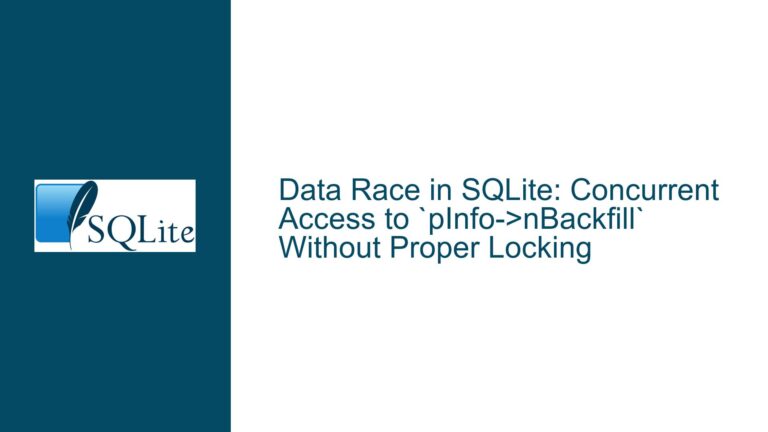Implementing Row-Level Locking in SQLite3 for Unix Systems
Understanding Row-Level Locking in SQLite3 and Its Implications
Row-level locking is a database concurrency control mechanism that allows multiple transactions to interact with different rows of the same table simultaneously without causing conflicts. In SQLite3, the default locking mechanism is at the database level, which means that when a write operation is performed, the entire database is locked, preventing other write operations from occurring until the lock is released. This can lead to performance bottlenecks, especially in high-concurrency environments where multiple processes or threads need to write to the same table.
The desire to implement row-level locking in SQLite3 stems from the need to improve concurrency and reduce contention among multiple processes or threads that are writing to the same table. With row-level locking, only the specific rows being modified would be locked, allowing other processes or threads to write to different rows in the same table without waiting for the lock to be released. This would significantly enhance the performance and scalability of SQLite3 in multi-process or multi-threaded applications.
However, implementing row-level locking in SQLite3 is not a straightforward task. SQLite3 is designed as a serverless, self-contained database engine, which means it does not have a central server process to manage locks. Instead, SQLite3 relies on file-system locks to manage concurrency. This design choice simplifies the architecture and makes SQLite3 lightweight and easy to deploy, but it also limits the granularity of locking to the entire database or, in some cases, individual tables.
Challenges and Considerations for Implementing Row-Level Locking in SQLite3
The primary challenge in implementing row-level locking in SQLite3 is the lack of a central lock manager. In traditional database systems, a central server process manages locks at various levels (database, table, row), ensuring that transactions do not conflict with each other. In SQLite3, however, the locking mechanism is decentralized and relies on the underlying file system’s capabilities. This makes it difficult to implement fine-grained locking, such as row-level locking, without significant changes to the core architecture of SQLite3.
Another consideration is the potential for deadlocks. Deadlocks occur when two or more transactions are waiting for each other to release locks, resulting in a situation where none of the transactions can proceed. While row-level locking can reduce the likelihood of deadlocks compared to database-level locking, it does not eliminate the possibility entirely. Implementing row-level locking would require careful design to minimize the risk of deadlocks, especially in complex transactions that involve multiple rows and tables.
Additionally, implementing row-level locking would require changes to the SQLite3 codebase, which is a complex and highly optimized piece of software. Any changes to the locking mechanism would need to be thoroughly tested to ensure that they do not introduce new bugs or performance regressions. This would require a deep understanding of the SQLite3 internals, as well as a significant investment of time and effort.
Strategies for Implementing Row-Level Locking in SQLite3
One possible strategy for implementing row-level locking in SQLite3 is to leverage an external library or extension that provides fine-grained locking capabilities. For example, the HCTREE extension (mentioned in the discussion) is a custom storage engine for SQLite3 that supports row-level locking. By integrating HCTREE or a similar extension into SQLite3, it may be possible to achieve row-level locking without making extensive changes to the core SQLite3 codebase.
Another approach is to modify the SQLite3 codebase to introduce a new locking mechanism that supports row-level locking. This would involve adding a new lock manager that tracks locks at the row level and ensures that transactions do not conflict with each other. The lock manager would need to be tightly integrated with the existing SQLite3 transaction and concurrency control mechanisms to ensure that it works correctly and efficiently.
A third option is to use a combination of application-level locking and SQLite3’s existing locking mechanisms to achieve a form of row-level locking. For example, an application could use a separate table or data structure to track which rows are locked by which transactions. When a transaction wants to modify a row, it would first check the lock table to see if the row is already locked by another transaction. If the row is not locked, the transaction would acquire a lock by updating the lock table and then proceed with the modification. This approach would require careful coordination between transactions to avoid deadlocks and ensure consistency.
Detailed Steps for Implementing Row-Level Locking in SQLite3
Evaluate the Need for Row-Level Locking: Before attempting to implement row-level locking, it is important to evaluate whether it is truly necessary for your use case. Consider the concurrency requirements of your application, the frequency of write operations, and the potential performance impact of database-level locking. If row-level locking is deemed necessary, proceed to the next steps.
Research Existing Solutions: Investigate whether there are existing libraries or extensions that provide row-level locking for SQLite3. For example, the HCTREE extension is a custom storage engine that supports row-level locking. Evaluate whether these solutions meet your requirements and whether they can be integrated into your application.
Modify the SQLite3 Codebase: If no existing solutions meet your needs, consider modifying the SQLite3 codebase to implement row-level locking. This will require a deep understanding of the SQLite3 internals, including the transaction and concurrency control mechanisms. Start by adding a new lock manager that tracks locks at the row level. Ensure that the lock manager is tightly integrated with the existing SQLite3 code to avoid introducing new bugs or performance regressions.
Implement Application-Level Locking: If modifying the SQLite3 codebase is not feasible, consider implementing application-level locking. Create a separate table or data structure to track which rows are locked by which transactions. When a transaction wants to modify a row, it should first check the lock table to see if the row is already locked. If the row is not locked, the transaction should acquire a lock by updating the lock table and then proceed with the modification. Be sure to handle deadlocks and ensure consistency between transactions.
Test Thoroughly: Regardless of the approach you choose, it is essential to thoroughly test the implementation to ensure that it works correctly and efficiently. Test for concurrency issues, deadlocks, and performance regressions. Use a combination of unit tests, integration tests, and stress tests to validate the implementation.
Monitor and Optimize: After deploying the row-level locking implementation, monitor its performance and behavior in production. Use profiling tools to identify any performance bottlenecks or issues. Optimize the implementation as needed to ensure that it meets the concurrency and performance requirements of your application.
Conclusion
Implementing row-level locking in SQLite3 is a complex and challenging task that requires a deep understanding of the SQLite3 internals and careful consideration of the potential trade-offs. While SQLite3’s default database-level locking mechanism is sufficient for many use cases, there are scenarios where row-level locking can provide significant performance and scalability benefits. By evaluating the need for row-level locking, researching existing solutions, and carefully implementing and testing the chosen approach, it is possible to achieve row-level locking in SQLite3 and unlock its full potential in high-concurrency environments.






